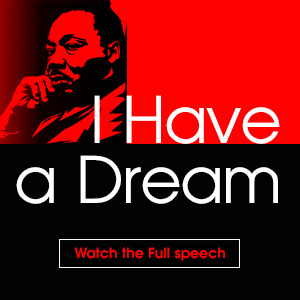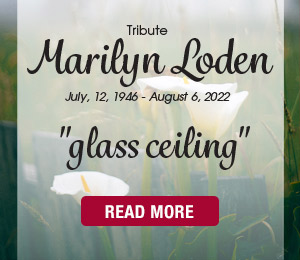By Donald Fan, Senior Director, Global Office of Culture, Diversity, Equity & Inclusion for Walmart

In 2018, 20,000 Google employees walked out to protest the handling of sexual harassment claims in the workplace. That headline-grabbing protest and related appeals have extended into this year. We know Goggle pledges to strengthen its commitment to equity and inclusion, which helps the company build more helpful products for its users and the world. This case implies that without a supportive culture, equity will not be sustained and will not help retain the best talent in the workplace.
After my previous articles on equity in the workplace pivoting on the rationale of equity, its implication, and programmatic practices, I believe it is worthwhile to discuss the cultural dimension of equity—building a culture of equity and inclusivity.
Characters of a culture of equity and inclusivity
A culture of equity and inclusivity exemplifies the value, purpose, policy, practice, and behavior that ensure that all people have fair and equitable support and opportunities to learn, grow, and advance, including, but not limited to, those who have been historically underrepresented based on race/ethnicity, age, disability, sexual orientation, gender, gender identity, socioeconomic status, geography, country of origin, or religion.
Although technology may be pervasive in the post-pandemic and digital era, ultimately, a culture of equity and inclusivity will have the most imperative and formative impact on the business world.
Some key traits of this culture include the following:
- Having a level playing field for everyone
- Offering fair access, opportunity, resources to learn, development, advancement
- Providing psychological safety, so all employees can bring their whole selves to work and contribute
- Nurturing a strong sense of belonging, uniqueness, and fairness
- Respecting the individual and treating each one with dignity
- Celebrating difference and building on commonality
This culture underlines empathy, humanity, and trust as a capstone of diversity, equity, and inclusion. It differentiates a genuinely diverse and inclusive organization from those that are not because it taps the benefits of a diverse workplace and ensures that a wide range of perspectives and experiences are heard, valued, and embraced.
A plurality of professionals (32%) surveyed by Korn Ferry said they plan to leave because they disliked the culture at their organization. We all heard that culture eats strategy for breakfast. No matter how robust our strategic plan is, if our people do not share an ethical culture, its efficacy will be held back because the people implementing the plan are the ones that make all the difference.
Leverage cultural intelligence (CQ) to build a culture of equity and inclusivity
In the book Cultural Intelligence, professors Christopher Earley and Soon Ang introduced Cultural Intelligence, also known as Cultural Quotient (CQ). CQ refers to the skill and competence to relate and work effectively in culturally diverse situations. People with high cultural intelligence are attuned to the values, beliefs, attitudes, and behaviors of people from different cultures and backgrounds.
Developing people with the skills and competences of cultural intelligence is vital in cultivating a culture of equity and inclusivity because that effort advances the cultural competence, agility, creativity, resilience, and adaptability of today’s changing business and workforce.
The four capabilities that stem from cultural intelligence: CQ Drive (Motivation), CQ Knowledge (Cognition), CQ Strategy (Meta-Cognition), and CQ Action (Behavior).
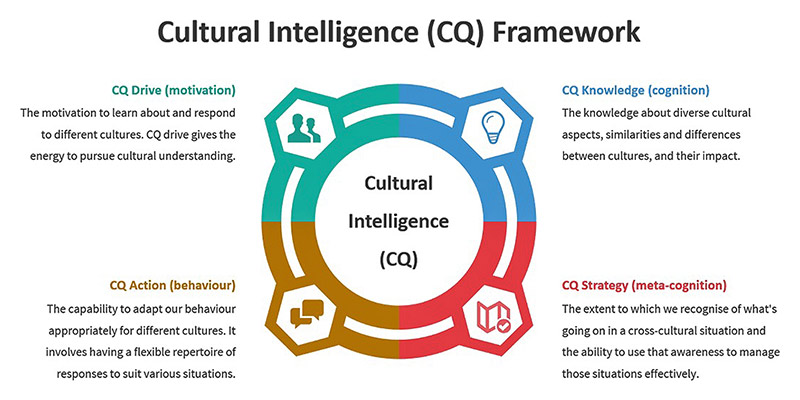
Source: betterboards.net
CQ-Drive is our interest and confidence in functioning effectively in culturally diverse settings. It is the motivation to learn about and respond to people different from us. When we make an effort to learn about others, our minds start to open up, and differences become interesting and exciting.
CQ-Drive includes intrinsic interest—deriving enjoyment from culturally diverse experiences; extrinsic interest—gaining benefits from culturally diverse backgrounds; self-efficacy—having the confidence to be effective in culturally diverse situations.
To strengthen CQ Drive, we should do the following: remain curious and explore new experiences, such as engaging with people from different backgrounds and volunteering to collaborate with cross-functional teams and community-based organizations; take time to understand and embrace the merits of differences and shared values; create a feedback loop and open channels for unique perspectives; and hold one another accountable for acting inclusively.
A workplace culture of equity and inclusivity can only exist when there is psychological safety. In a psychologically safe setting, employees, regardless of status or identity, feel they can speak up, exchange thoughts, contribute, and take risks without fear of threats to their status or employment. When leaders and organizations model vulnerability, normalize risk-taking, or learn from failure, trust-based relationships are created. In this environment, underrepresented talent feels empowered to take the interpersonal risk of sharing their ideas and unique viewpoints. Psychological safety in the workplace serves as a CQ Drive, helping nurture a greater sense of belonging and support.
CQ-Knowledge is our knowledge about how cultures and race/ ethnicity groups are similar and different. It is about knowing how culture in general shapes people’s behaviors, values, and beliefs. Core cultural differences are invisible and they are often overlooked. CQ Knowledge helps to overcome cultural blind spots. With that, we can better explain and predict the responses of others, and thereby prevent confusion and anxiety in diverse settings.
CQ Knowledge incorporates business know-how regarding economic and market systems; interpersonal know-how regarding values, social interaction norms, and religious beliefs; and socio-linguistics know-how regarding rules of languages and ways for expressing nonverbal behaviors. The language of a particular culture also influences how people think.
To enrich CQ Knowledge, be purposeful in learning cultural differences to improve problem identification and resolution, judgment, and risk assessment. By understanding other people’s intentions, actions, and viewpoints, CQ Knowledge tempers bias and stereotypes, promoting trust-based interpersonal relationships. It also helps close the gap between in-group and out-group with freedom of cultural exchange, a sense of belonging, and purpose alignment.
When everyone commits to learning from others and brings the entirety of one’s life experiences, we have so much more to offer each other. If we try hard enough, we can find the unfamiliar in the familiar.
Effective leadership cultivates a deep understanding of who we are as individuals with different backgrounds. Knowing how we make decisions and why we make them the way we do is critical. Recognizing our individual biases and blind spots is foundational. We must develop the ability to determine when these parts of ourselves get in the way of our capacity to lead from a place of transparency. Effective leadership leads with an open mind, authenticity, vulnerability, and courage.
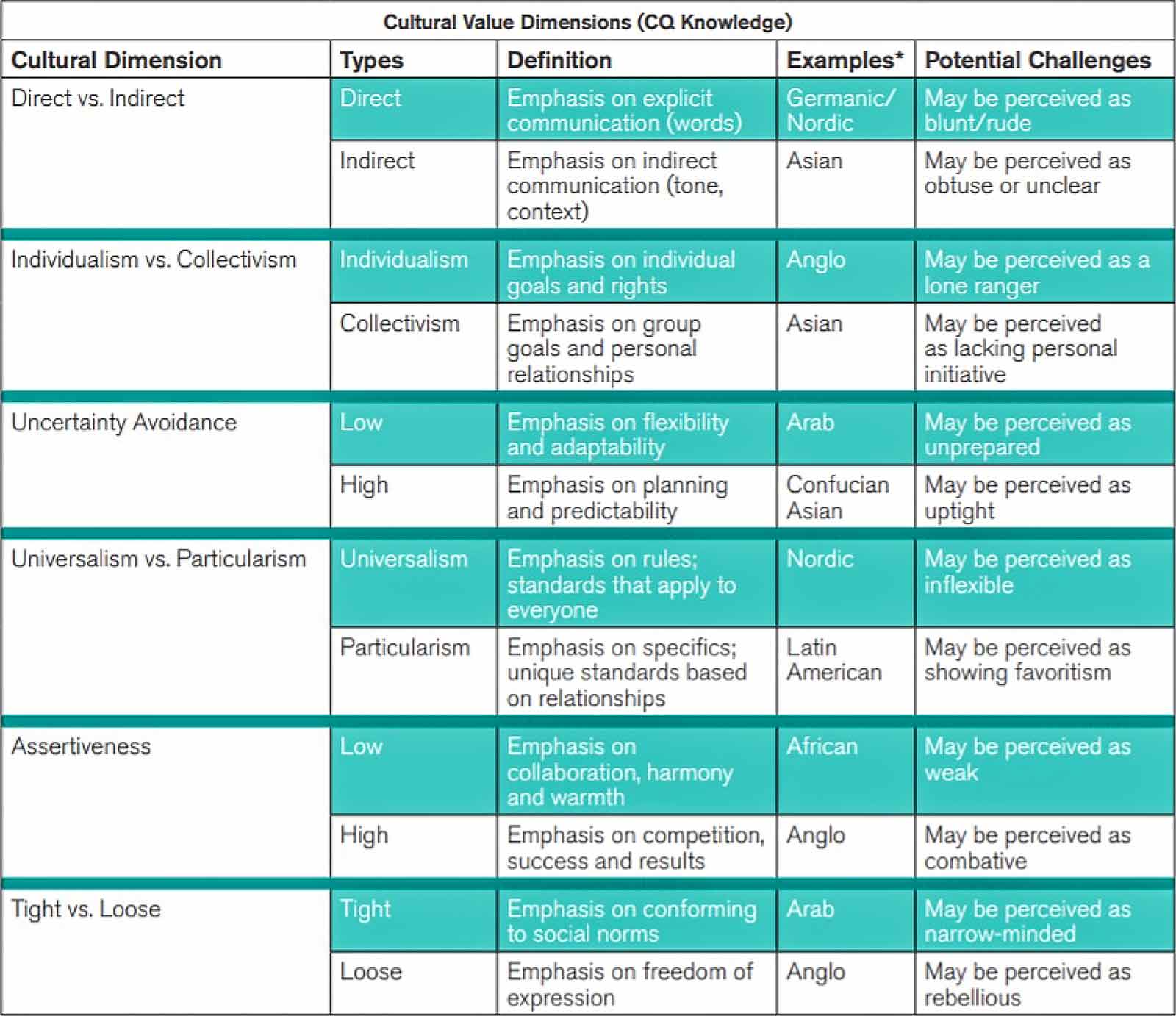
*These are examples of cultures where this cultural value is strong, but always be prepared for exceptions in any culture. Source: shrm.org
CQ-Strategy is how we make sense of culturally diverse experiences. It refers to higher-level thinking skills used to manage diversity: drawing on our knowledge and experience to anticipate and respond to cultural differences; being consciously alert and mentally flexible during exchanges; and reflecting on the accuracy of our assumptions, interpretations, and predictions, and then adjusting them as new information comes to hand.
CQ Strategy involves awareness—knowing about our existing cultural knowledge, planning (strategizing before a culturally diverse encounter); and checking assumptions and adjusting mental maps when actual experiences differ from expectations.
To enhance CQ Strategy, we can take on the concept Reflection-in-Action. It is the retrospective contemplation of practice, using analyzing, observing, and listening to solve problems. The focus is on gaining a new perspective—changing our views, values, and beliefs, rather than merely looking for a resolution. When possessing a strong CQ Strategy, we can draw on cultural understanding to solve complex problems.
Organizations should think about what strategies and practices can enhance their employees’ cultural experience. Then, plan and offer various activities that enrich cultural learning and involvement, such as heritage month celebrations, religious holiday observances, E/BRG activities, reverse mentoring, sponsorship, cultural conversations, and more. Adopt findings from anthropology to understand why people differ in their beliefs and behaviors. That effort helps make invisible cultural elements visible and unconscious bias conscious at work.
CQ-Action is our ability to adapt verbal and nonverbal behavior to make it appropriate for diverse cultures and people different from us. It involves having a flexible repertoire of behavioral responses that suit a variety of situations. If we are accustomed to thinking about these differences and their impact, this process can soon become instinctive and naturally feed into our planning.
CQ Action involves modifying nonverbal behaviors (e.g., gestures, facial expressions) and verbal behaviors (e.g., accent, tone).
Two thousand years ago, Aristotle introduced the seven causes of human action. He noted that all human actions have one or more of these seven causes: chance, nature, compulsion, habit, reason, passion, and desire. If we understand how the causes affect people in specific ways, we may better influence them and motivate them effectively. To improve CQ Action, we should question our assumptions about why things happen differently in different cultures and journal our cultural experiences and observations with success as well as frustration. That effort helps us address immediate problems and keeps us focused on improving our CQ in the long term.
In an organization, the exercise of establishing cultural values for DEI is critical, but not enough. The real test is how leaders enact these values. People watch everything leaders do. If leaders are not exhibiting behaviors that reflect the established values, the values are meaningless. Leaders need to listen, invite input, and foster creative conflict. It is not enough just to hear people out—words without action breed cynicism and plant the seeds of future talent attrition. Leaders must make a conscious effort to create a culture where people do not feel like imposters or left out.
Conclusion
Keep in mind that cultural intelligence development requires the head (knowledge and understanding), the body (actions), and the heart (confidence and commitment).
Building a culture of equity and inclusivity is everyone’s business. Every leader and employee must be on board for a cohesive and meaningful culture to propagate. Great organizations and leaders commit to and invest in the corporate culture by intentionally integrating CQ development into leadership competence learning programs; diversity, equity, inclusion strategy; and E/BRG initiatives. They leverage allyship and role model inclusive behaviors to create a safe space, a sense of belonging, and continuous learning from one another. That is how we close the cultural gaps, attract and retain top talent, achieve innovative breakthroughs, and outperform the competition with high-performing teams.
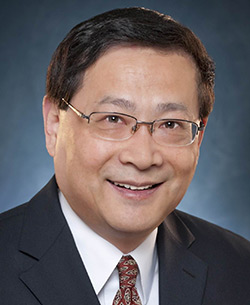
Donald Fan
Donald Fan serves as Senior Director in the Global Office of Culture, Diversity, Equity & Inclusion at Walmart Inc.
By Crystal M. Brown, APR
I started working remote in 2018. After spending a decade in an office, I found myself setting up my workspace just 10 feet from my bedroom. That was only three years ago, but remote roles were few and far between.
Then 2020 happened, and the pandemic sent #WFH trending. More than a year later, we have widespread vaccine availability in the United States and a rise in those who are inoculated.
As conversations arise regarding the return to office, employers should consider the importance of remote options as key to supporting diversity, equity, and inclusion. Particularly for women.
We hear a lot about how work/life balance can benefit from working remote for good reason, considering how working remote contributes to employee happiness and, in turn, retention. But for me, working remote is just as important to my professional mobility as it is to my work/life balance.
Remote Flexibility Amplifies Professional Mobility
The old adage is true, it’s all about location, location, location.
Remote options offer flexibility in location, especially for those who are fully remote when it comes to professional mobility, which is the movement and progression of an employee across levels, roles, and even industries. It is easier to make the jump from one role to another, one function to another, one industry to another. We no longer have to wait until that one role we want is open because it is the only one that we are interested in within in our physical radius. We can make those lateral and vertical moves today, saving us from complacency and maximizing our precious time.
I have heard so many stories of women turning down opportunities for personal reasons (usually because their partner’s work would not allow them to relocate). To illustrate, I once heard from an executive who had offered an open C-suite role to three different women who all turned it down because they were unable to move due to their partner’s work. Ultimately, the role went to the fourth person asked, a man. In an ironic twist, he was not required to relocate; they allowed him to telecommute (which is another conversation).
Today, I mentor women who are in their early 20s and already positioning for a career in the virtual world. They are looking long term and know they want to have both a fulfilling career and personal life and they recognize that one of the best ways to do that is with remote work. They are literally furthering career growth through flexibility and work/life balance for themselves.
These examples speak to the point that companies that offer remote options will not only have a greater pool of skilled talent, they will also achieve higher success with their DEI goals. They also demonstrate why it is important for employees to continue to advocate for remote work.
Tipping Point
Remote flexibility is a critical opportunity for gaining momentum in professional mobility and advancement for women. One thing is certain: the pandemic challenged the traditional American work culture. If there was ever a time for change, it is now.

Crystal M. Brown
Crystal M. Brown (she/her) is a communications and marketing leader, and partner for global companies. Her career of more than a decade spans the industries of engineering, construction, manufacturing, and retail. She holds a Bachelor of Business Administration from the University of Oklahoma and is Accredited in Public Relations.
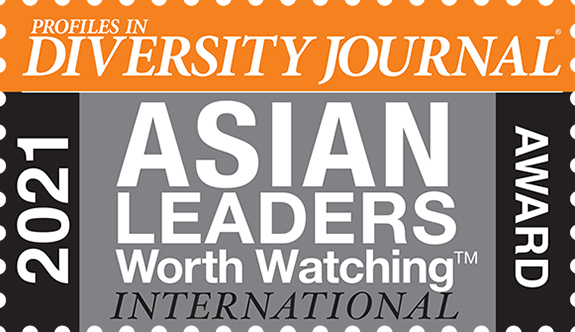
The 1st Annual Asian Leaders Worth Watching™ Awards
PDJ Salutes its Inaugural Class of Asian Leaders Worth Watching™ Award Winners
For more than two decades Profiles in Diversity Journal has honored outstanding individuals who have blazed new trails, welcomed challenges, mentored others, advanced diversity and inclusion in the workplace and the community, and excelled in their chosen fields. Now, PDJ is honoring Asian Leaders with our first-ever Asian Leaders Worth Watching Awards.
The 24 profiles that appear in this issue recognize and celebrate the hard work and impressive achievements of these Asian Leaders. Each award recipient has also provided us with the answers to some interesting questions and an essay that will give you, our readers, a chance to get to know these multitalented, multilingual, and trailblazing individuals a little better.
Welcome to PDJ’s first annual Asian Leaders Worth Watching Awards.
2021 Asian Leaders Worth Watching™ Award Winners
- Activision Blizzard – Ken Wee – Chief Strategy Officer
- Akin Gump Strauss Hauer & Feld LLP – Alison Chen – Partner
- Akin Gump Strauss Hauer & Feld LLP – Arshi Siddiqui – Partner
- Best Best & Krieger LLP – HongDao Nguyen – Partner
- Dechert LLP – Angela M. Liu – Partner
- EY – Sandra Baker Zarraga – Principal, Financial Services Consulting
- HARMAN International – Lily Guo – Vice President, Global Operations, HARMAN Lifestyle Consumer Audio
- HARMAN International – Kelei Shen – Chief Technology Officer
- Kelley Kronenberg – Harsh Arora – Partner
- Kindred Healthcare – June Dumaguet, MSN, RN, NE-BC – Chief Clinical Officer
- Latham & Watkins LLP – Lisa Kim Anh Nguyen – Partner
- Latham & Watkins LLP – Shagufa Hossain – Partner
- Moss Adams LLP – Annie Yuan Norviel – Audit Senior Manager
- Nelson Mullins Riley & Scarborough LLP – Jeong-Hwa “June” Lee – Partner
- New American Funding – Karen Chiu – Builder Division Development Manager
- New York Life Insurance Company – Melissa Kuan – Chief Strategy Officer, New York Life Investment Management
- Norton Rose Fulbright US LLP – Gina N. Shishima – U.S. Chief Strategy and Operations Partner
- RBC Capital Markets – Nancy Huynh – Global Head of Business Architecture, Client Technology
- S&P Dow Jones Indices – Jaspreet Duhra – Managing Director, Head of EMEA ESG Indices
- S&P Dow Jones Indices – Aye Soe – Managing Director, Global Head of Product Management
- S&P Global – Karen Chu – Associate, Corporate Ratings
- S&P Global – Shahzeb K. Rao – Senior Director, Strategy and Strategic Initiatives
- Walmart Inc. – Ella Chan – Vice President, Business Initiatives–Sam’s Club
- Walmart Inc. – Parvez Musani – Vice President, Transportation and Last Mile Technology
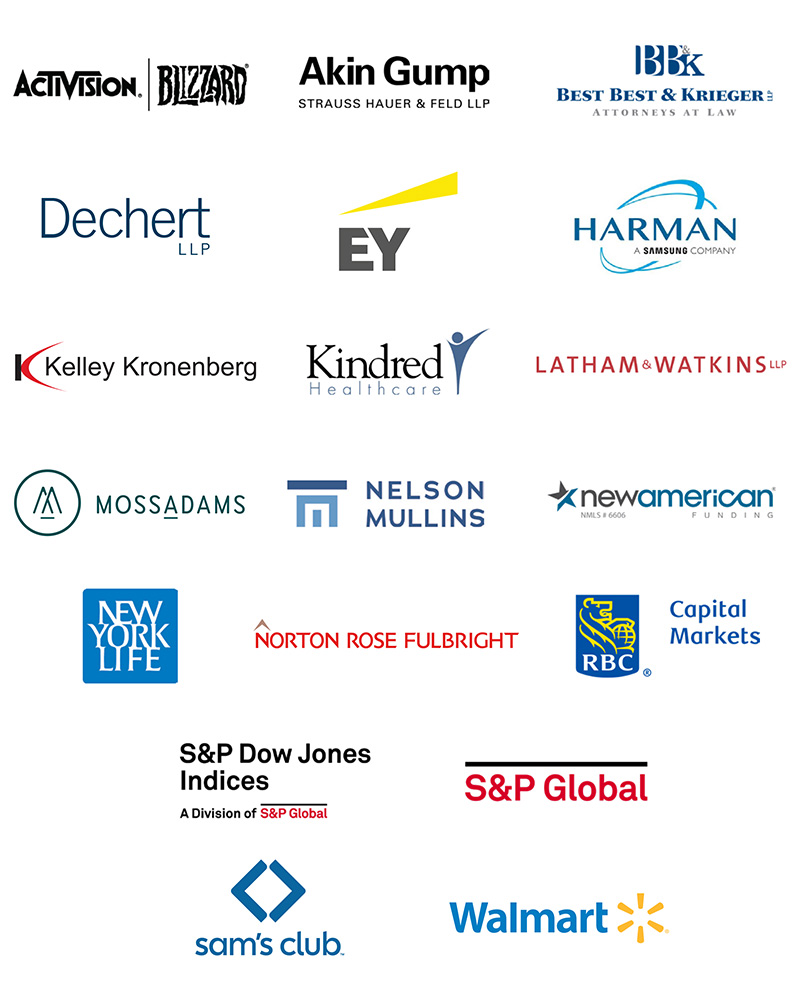
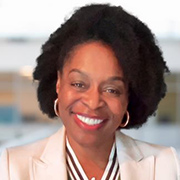
Dionne Wallace Oakley
Chief Human Resources Officer and Chief Diversity Officer
Freddie Mac Names Dionne Wallace Oakley as Chief Human Resources Officer and Chief Diversity Officer
MCLEAN, Va. Aug. 2, 2021 – Freddie Mac (OTCQB: FMCC) today announced that Dionne Wallace Oakley will serve as the company’s senior vice president, chief human resources officer (CHRO) and chief diversity officer (CDO). In this role, Wallace Oakley will be a member of the company’s senior operating committee and will report directly to Freddie Mac CEO Michael DeVito.
“It is with great pleasure that we announce Dionne Wallace Oakley as our next head of Human Resources and Chief Diversity Officer,” said Michael DeVito, CEO of Freddie Mac. “Ms. Wallace Oakley has extensive experience across the insurance and financial services industry, and she will be at the forefront of many very important initiatives for the company, including talent acquisition, leadership development and our diversity, equity, and inclusion efforts. I thank Angela Locke for her dedication to our company by serving in an interim role for the past seven months.”
Ms. Wallace Oakley brings over 20 years of human resources experience to Freddie Mac, most recently serving as executive vice president, human resources and strategy at Erie Insurance. In this role, she oversaw human resources, strategic communications, strategy and privacy. She also spent more than two decades at State Farm Insurance where she progressed through multiple positions and disciplines ranging from underwriting, public affairs, auto claims and human resources.
“I am excited to join Freddie Mac at this critical moment for the company and our country,” said Wallace Oakley. “I’m looking forward to supporting Freddie Mac’s strong culture and talented workforce as we seek to address important issues of diversity, equity and inclusion we face as a nation. I’m also pleased to contribute to the company’s mission of making home possible for millions of homeowners and renters from every background.”
Wallace Oakley will start on September 15.
Wallace Oakley earned a bachelor’s degree in marketing and business from Delaware State University and master’s in human resource development from Towson University in Baltimore. She is active in the community, a member of the Delta Sigma Theta Sorority, Inc. and a member of the HR Policy Association, the lead public policy organization of CHROs.
About Freddie Mac
Freddie Mac makes home possible for millions of families and individuals by providing mortgage capital to lenders. Since our creation by Congress in 1970, we’ve made housing more accessible and affordable for homebuyers and renters in communities nationwide. We are building a better housing finance system for homebuyers, renters, lenders and taxpayers. Learn more at FreddieMac.com, Twitter @FreddieMac and Freddie Mac’s blog FreddieMac.com/blog.
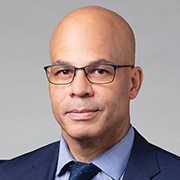
Darwin Conner
US Chief Diversity, Equity & Inclusion Officer
Eversheds Sutherland Welcomes Darwin Conner as New US Chief Diversity, Equity & Inclusion Officer
NEW YORK—Eversheds Sutherland is pleased to announce that Darwin Conner has joined the firm as US Chief Diversity, Equity & Inclusion (DEI) Officer, resident in the New York office. Mr. Conner will oversee the continuation, further development and implementation of initiatives and programs that champion Eversheds Sutherland’s commitment to fostering inclusivity and equity at every level and in every function, both within the firm – including recruiting, professional development, public service and client and practice development – and beyond. In this role, Mr. Conner will work in tandem with Tax and US DEI Partner Vanessa A. Scott on internal and external programs that build on and leverage Eversheds Sutherland’s already robust DEI platform.
Mr. Conner brings a unique perspective to his new role having practiced corporate finance law for more than 20 years, most recently as a partner at Sullivan & Worcester, LLP, and at Winston & Strawn, LLP, before that. In addition to his practice, Mr. Conner played an integral role in developing antiracist frameworks at his respective law firms and subsequently decided to return to school to obtain a Masters in Diversity and Inclusion Leadership from Tufts University.
“We are incredibly fortunate to have Darwin join Eversheds Sutherland. Not only is our DEI program important to our firm internally, it is also integral to our core value of helping our communities to thrive,” said Mark D. Wasserman, Co-CEO of Eversheds Sutherland. “Our clients will benefit from Darwin’s background as a practicing lawyer who understands how to integrate DEI programs into top flight client service. We have long had a commitment to improving diversity, inclusion and equity at our firm and in the legal sector, but if the last year and a half has shown us anything, it is that there is still a tremendous amount of work to do. Under Darwin’s leadership, I am confident Eversheds Sutherland will be an industry leader in effecting profound, lasting change in equity and inclusivity.”
“I am very proud of some of our recent DEI milestones, including being a founding firm of the Move the Needle Fund and receiving Mansfield certification multiple years in a row,” said Ms. Scott. “I am excited to welcome Darwin to our team and to work alongside him as he builds on the work we have done and elevates our DEI strategy moving forward.”
As mentioned, Mr. Conner was most recently a corporate finance partner at Sullivan & Worcester, LLP, and at Winston & Strawn, LLP. He has extensive experience shaping and managing DEI initiatives across the legal industry. Most recently, he served on the Executive Council of the Leadership Council on Legal Diversity (LCLD) and as chair of the DEI Committee and member of the Hiring Committee at Sullivan & Worcester, where he guided the firm’s strategic DEI efforts. Mr. Conner will complete his M.A. in Diversity and Inclusion Leadership from Tufts University later this year; he also holds a J.D. from Fordham University and a B.A. from Carleton College.
About Eversheds Sutherland
As a global top 10 law practice, Eversheds Sutherland provides legal services to a global client base ranging from small and mid-sized businesses to the largest multinationals, acting for 70 of the Fortune 100, 61 of the FTSE 100 and 128 of the Fortune 200.
With more than 3,000 lawyers, Eversheds Sutherland operates in 74 offices in 35 jurisdictions across Africa, Asia, Europe, the Middle East and the United States. In addition, a network of more than 200 related law firms, including formalized alliances in Latin America, Asia Pacific and Africa, provide support around the globe.
Eversheds Sutherland provides the full range of legal services, including corporate and M&A; dispute resolution and litigation; energy and infrastructure; finance; human capital and labor law; intellectual property; real estate and construction; and tax.
Eversheds Sutherland is a global legal practice and comprises two separate legal entities: Eversheds Sutherland (International) LLP (headquartered in the UK) and Eversheds Sutherland (US) LLP (headquartered in the US), and their respective controlled, managed, affiliated and member firms. The use of the name Eversheds Sutherland is for description purposes only and does not imply that the member firms or their controlled, managed or affiliated entities are in a partnership or are part of a global LLP. For more information, visit eversheds-sutherland.com.
By Vicki Thrasher, Senior Vice President of Human Resources, Oracle Corp.

As a long-time human resources professional, I find it encouraging to see how many employers are embracing the notion of hiring people who think and learn differently.
Increasingly, corporate Diversity and Inclusion (D&I) programs include neurodiverse people, meaning those with forms of autism, dyslexia, dyscalculia (difficulty with math), Tourette syndrome, ADHD, and other conditions.
Numbers vary widely on how many people fall into these categories—a conservative estimate is 17 percent of the general population, but many suspect the percentage is far higher due to the number of people who have not been diagnosed. But whatever the actual number, this is a large demographic that companies can hire, train, and retain.
Here’s how businesses—and we as HR professionals—can expedite that process.
Education is the Key—for Everyone
HR professionals need to educate themselves and others, including senior management, about what neurodiversity means. A good start is to realize that, yes, neurodiverse people may be different from neurotypical people, but they also possess unique skills that can be invaluable to a team and an organization.
This means employers must learn how to communicate effectively with neurodiverse people by understanding that these different thinking processes can require different techniques. For example, in addition to verbal instructions, writing down tasks in person or following a meeting can be helpful techniques.
These differences are also a key reason that companies would benefit from neurodiverse skill sets. But more on that later.
Seek out Executive Allies
In a corporate setting, it’s critical to identify executive sponsors who will advocate for the hiring and retention of neurodiverse employees. Executive allies are essential in building a culture where employees feel supported and valued on the team. One way to build your executive ally bench is to effectively communicate the value proposition of hiring neurodiverse talent and how that will benefit the organization. You never know, they could belong to this community themselves, or perhaps have friends or family members who are neurodiverse. Starting the conversation is the first step.
Promote Employee-Led Employee Resource Groups
Companies should also support the formation of Employee Resource Groups (ERGs) for neurodiverse people. These employee- led communities meet to discuss common issues and priorities regarding how to better support each other in the workplace while providing connection to others within the community. Large companies like Oracle typically support ERGs for Black, Asian, Latino, and LGBTQ people, as well as women, veterans, and people of various generations, among others. Creating a neurodiversity ERG can help foster a greater sense of belonging for employees within that community, while providing a valuable avenue to help educate the broader organization about working with neurodiverse colleagues.
Create New Hiring and Training Techniques
As noted, neurodiverse people may process new information in unique ways. That means companies should develop plans to recruit and bring neurodiverse people on board in relevant and productive ways. For example, since many people with autism find initial social interactions challenging, some companies are changing technical interviews from one-on-one talks to a set of problem solving challenges. Other solutions include coaching hiring managers regarding how candidates may not be able to maintain direct eye contact or how panel interviews may not be effective.
For new hires, making sure managers clearly outline tasks and assignments, and allowing sufficient time for prospective hires to acculturate to new processes, will boost their chances of success. For many people with autism, it is also helpful to break bigger projects down into smaller, discrete tasks.
Why Cultivating Diversity and Inclusion Helps Your Business
As forward-thinking managers know, welcoming diverse people to the workforce isn’t just the right thing to do, it’s also good business. By bringing in people of differing viewpoints and abilities, organizations get a fuller picture of how their products and services are perceived and accepted (or not) by different people.
If everyone on staff is a middle-aged neurotypical male (nonminority), chances are you’re getting a very limited view of how you’re perceived by the markets generally. If, on the other hand, you bring in people who see and process information differently, you will get a fuller, more 3-D view, and perhaps even new ideas for products. Last fall CBS’s 60 Minutes did a fascinating segment on this topic.
Companies embracing diversity and inclusion get broader insights into how to develop products and sell to millions of people. Making use of the wonderful diverse complexities of our world is how companies can win in the marketplace and enrich their internal culture. New perspectives and opportunities for all can lead to great outcomes for both business and society.
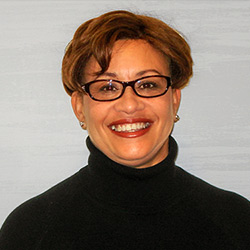
Vickie Thrasher
Vickie Thrasher currently serves as Oracle’s senior vice president of HR. In her current role, she leads Oracle’s Organization Talent Development, Diversity Compliance and Inclusion, Employment Practices, Oracle Women’s Leadership, Top Talent Development, HR Strategic Communications, and Organization Design and Insights.
Vickie joined Oracle Corporation in 1996 as an HR consultant and in 2000, she was promoted to vice president of business HR for North America Sales. As Oracle experienced exceptional growth, she was given additional responsibility, ultimately responsible for Business HR for the Americas. She has directed and led a variety of major initiatives in the areas of Talent and Performance Management, as well as M&A integration. With more than two decades of HR experience, Vickie has led HR teams across a variety of industries, including manufacturing, health care, telecommunications, and information technology.
Vickie attended Michigan State University earning a BA in Social Science, Labor and Industrial Relations and Saint Francis University of Pennsylvania earning a MA in Industrial Relations. She currently lives with her husband Greg, in the DC metropolitan area.
By Donald Fan, Senior Director, Global Office of Culture, Diversity, Equity & Inclusion for Walmart

Albert Einstein said, “You can’t use an old map to explore a new world.” While reimaging the post-COVID-19 age, we must remap our ways of thinking and ways of working. Can the future of work create not only economic value but also reflect our social and communal values? Putting equity center stage all the time is an essential component of this new mental model.
Equity is the lifeline for winning the talent war in the upcoming decade, a competitive advantage of thriving in the fourth industrial revolution, and a determining factor to achieve racial and gender justice.
Why
First, more and more organizations realize the crucial role equity plays on many fronts. According to Google Trends, the use of “Equity” shows an upward trend, as users searching business and industrial made the acronym “DEI” 200 percent more popular in the second half of 2020 than it was in the same period five years before.
Secondly, embracing equity is a strategic imperative to catalyze breakthrough growth. Each year, Conference Board conducts a global survey of CEOs to discover what keeps them awake at night. That survey found that business growth in a disruptive world, talent war, and development of next-gen leaders remain the top challenges. Research proves time and again that organizations exercising equity attract and retain high-caliber talent and have a fair chance to compete successfully and win the game.
Internally, these organizations foster a level playing field with an inclusive culture by offering equitable opportunities and access to everyone. They benefit in several ways: Equity empowers cognitive diversity in decision-making and problem-solving. Equity enriches talent experience and engagement. Equity prevents bias, favoritism, and partiality in people decisions, and ultimately, improves talent retention. Externally, equity helps make environmental, social, and governance issues part of the core strategy and demonstrates deliverable value.
Thirdly, practicing equity propels business results through value creation. As stated in a recent Deloitte study, not addressing critical racial inequity is estimated to have cost the U.S. economy $16 trillion over the past two decades. If the gaps were closed today, it is estimated that $5 trillion could be added to U.S. GDP over the next five years alone, including tens and even hundreds of billions more dollars spent on food, housing, apparel, transportation, and entertainment each year.
The study showed that organizations with inclusive cultures are twice as likely to meet or exceed financial targets as those without, three times as likely to be high performing, six times more likely to be innovative and agile, and eight times more likely to achieve better business outcomes.
Finally, equity is truly the capstone of the diversity, equity, inclusion (DEI) journey because it results in a strong sense of trust and engagement. Think it this way. Suppose diversity reflects a seat at the table (individual). In that case, inclusion is a voice at the table (interpersonal), and equity is how you react to the collective voice in practice (institutional). Without equity, you cannot harness the value of diversity and inclusion.
What
Equity simply means fairness and inclusivity by offering everyone an equitable opportunity and access to development, information, resource, and decision-making. Equity hinges on an objective rule-based discipline and trust-oriented culture. It entails removing hurdles such as favoritism, prejudice, xenophobia, and the consequences of these hurdles, such as injustice, disparity, and lack of access to all the things that create a safe and inclusive environment.
As the rhetoric around equity becomes more ubiquitous, equity and equality are often conflated. Equality refers to sameness and equity centers on fairness. In other words, equity focuses on providing people what they need to be successful by addressing disproportionality. In contrast, equality offers everyone the same thing by assuming proportionality, regardless of individualized need. In general, Equity is what happens when all underrepresented employees have equitable opportunities and support to succeed and grow.
You need to be aware of the difference between another pair of terms: systematic inequity and systemic inequity. “Systematic” implies a complete series of steps that you follow. It is explicit, like official policy or process. “Systemic” refers to the system itself. It is implicit, like unofficial practices or unwritten rules. It reflects a quality inherent in the system, not necessarily on purpose, but more that is just the way it works. Systematic inequity is a set of practices that discriminate based on gender, race, ability, and LGBTQ+. Systemic inequity describes a system that has imparity inherent in how it operates.
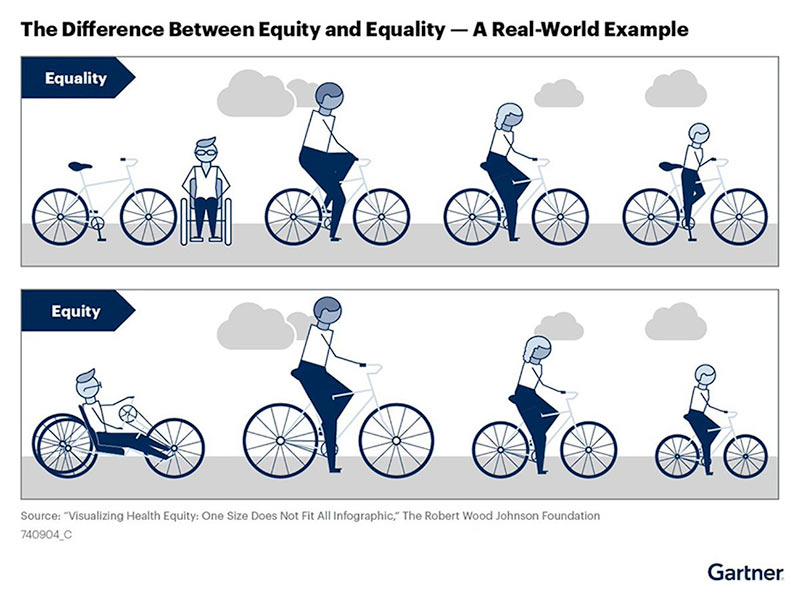
How
Today’s reality is we have a significant equity gap to close in the workplace. As reported from a recent McKinsey study, black employees experience less fairness and fewer chances to succeed. See the result below:
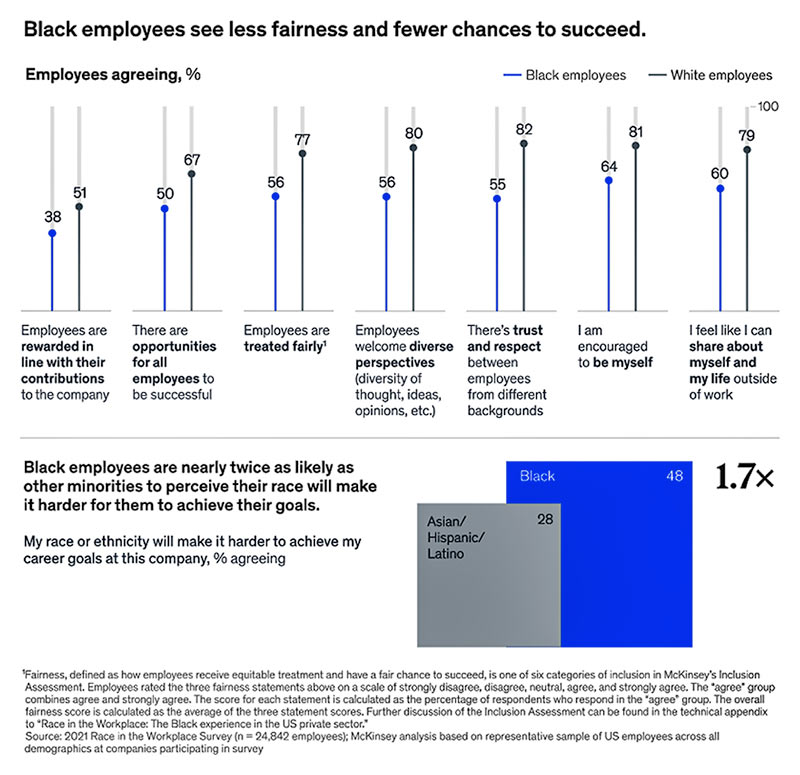
Inequity is a systemic problem that requires a systemic solution.
An equity strategy aims to level the playing field and ensure all employees feel psychologically safe to bring their whole selves to work. And everyone is offered a fair chance and equitable opportunity to learn, develop, and advance. That effort helps transit from an employee-centered value proposition to a human-centered value proposition that treats employees as people, not workers.
The equity strategy starts with organizational commitment, and leadership with empathy and authenticity. Intentionally revisit the current status and understand what brought you here. That assessment tells you where you want to play and how to win. You then hold people accountable for cultivating and sustaining an inclusive culture and equitable workplace. And you ensure that equity is central to every decision and career moment—from recruiting, hiring, and onboarding, to development, succession planning, and performance evaluation. Finally, communicate your equity narrative to the entire organization and invite everyone along on the journey.
How do you make equity center stage all the time?
According to Fortune/Deloitte’s 2021 CEO Survey, 90 percent of CEOs reported that diversity, equity, and inclusion are strategic and personal priorities. Moreover, 90 percent also said their company aspires to be an industry leader in DEI practices.
In order to build an equitable future, leaders must activate the full breadth of their control and influence across all parts of their organizations and beyond—from relationships to products, services to spend, and governance to external interactions.
Business executives must lead by example to advance equity. They must utilize their commitment and behavior to influence the behavior and performance of others around them, and speak out to cultivate a culture of equity and inclusiveness. C-suite leaders can consider some examples in the workplace:
Chief Executive Officer: Set vision and expectation; establish leadership commitments and hold C-suite leaders accountable for fostering a culture of equity and inclusion; ratify strategic priorities around diversity, equity, and inclusion; and lead with empathy and humanity through example
Chief HR Officer: Define workforce experience strategy to inform talent strategy and processes; design and deliver on financial, physical, mental, and emotional well-being through equitable rewards and other programs; monitor pay equity; lead succession strategy and planning; and enable a culture that embeds and values diversity, equity, and inclusion in all business operations
Chief Diversity, Equity, and Inclusion Officer: Set strategic priorities with board and CEO; collaborate with executive members to enable DEI in all spheres of influence; initiate and promote DEI programs; establish, evolve, and publish diversity analytics; and encourage transparency and accountability on DEI ambitions and results
Chief Technology Officer: Select and deploy technologies to sustain DEI; advocate data-driven decision-making; design and monitor information flow across the organization; consider biases and ethics in technology; and create and assess data analytics
In addition to leadership commitment, equity is formidable in practice because it calls for purposeful design and consistent effort—taking action against systemic bias, racism, and unequal treatment. Without demonstrating how equity works with specific examples in your organization, it is a vacant concept that erodes trust and serves to undercut equity.
Here are some practical examples that integrate equity in each of the crucial career moments:

Recruiting and Hiring–Nurture a broad sourcing pool, and attract underrepresented talent through innovative initiatives and a trusted brand name:
- Cast a broader net by diversifying candidate sources to reach an inclusive talent pool
- Rethink qualifications to attract candidates from nontraditional backgrounds
- Nudge recruiters and hiring managers at key points in the process to increase awareness of potential bias using AI
- Conduct an in-depth analysis of recruiting processes, such as application pool, screening result, interviewing candidates, and selection decision, to reveal potential bias in each step
- Require diverse slots and diverse interview panels to achieve a more equitable selection decision
Onboarding–Involve everyone deliberately to set them up for success and create an enjoyable experience for all in the early days:
- Emphasize equity, inclusion, and employee value proposition during the onboarding experience
- Establish a buddy system, where every new hire is paired with a cultural ambassador to show them the ropes and decrease their learning curve in a new work environment
- Introduce new hires to the ERG groups to engage them with a sense of community
- Create checkpoints to learn and understand new hires’ experiences and needs, and ensure that everyone has a level playing field to start his or her career with your organization.
Learning and Development–Purposefully invest in a robust talent pipeline and strengthen the talent bench of disenfranchised groups by aligning skills, abilities, and competencies with future organizational needs and changing business and talent strategies:
- Offer everyone equitable access to learning and development opportunities, and resources
- Re-skill diverse employees so they can move into jobs that are currently predominantly white or male; implement targeted development programs to teach learning agility and unlock their full potential
- Provide high-performers early access to sponsors to enrich their work experiences, expose them to senior executives, and accelerate their careers
- Incorporate talent development and succession requirements in all people managers’ performance goals
- Upskill employees to thrive in teams and position them to weather inevitable career challenges due to automation and digitalization
Performance Appraisal–Apply a meritocracy system with objective and unbiased standards to raise employee engagement and morale:
- Appraise employee performance and outcome, not appearance and background; communicate and apply an impartial framework and standard for appraisal ranking
- Create a feedback loop to give honest and constructive advice frequently
- Objectively identify “optimal” candidates for promotions and advancement using AI and machine learning
- Measure employees’ perception of belonging, fairness, uniqueness
- Tie DEI results to annual performance reviews and adopt a zero-tolerance policy with regard to harassment, discrimination, bigotry, and other non-inclusive behaviors
Compensation and Rewards–Incentivize all employees with fair pay and benefits based on contribution, competency development, adaptability, and potential:
- Commit to pay equity by reviewing compensation practices and conducting pay equity audits regularly to mitigate pay disparity
- Identify well-being offerings that help establish an emotional connection with employees; make employees’ overall mental, physical, and financial well-being a priority
- Offer inclusion perks and benefits centered around employee needs
- Ensure your employee value proposition speaks to underrepresented talent
Remote Experience–Reshape ways of working to meet the unique needs of an inclusive workforce:
- Break roles down into activities to determine which can be completed under flexible work arrangements tailored to employees’ personal and professional needs
- Identify ways to provide employees with options regarding where and when they can maintain productivity within the team context
- Provide virtual space for a remote team to share; test best practices and learn from peers
- Redesign virtual work and workspace attuned to inclusivity concerns and employee wellbeing, to increase innovation, performance, and morale
By embedding equity into the talent lifecycle, you enrich your employees’ experience; thus, you accelerate their engagement and productivity, and make your team high performing, dynamic, and resilient.
Closing
Fostering a culture of equity and inclusivity requires an evergreen commitment. We all have a pivotal role to play in reimagining the future, reframing the work, challenging the status quo, and transforming long-held beliefs and behaviors. To get there, we need to rethink and de-learn.
Adam Grant introduced the hierarchy of rethinking style in his latest book, Think Again: The Power of Knowing What You Don’t Know, which advocates thinking like a scientist (seeking out experts who disagree with you and weighing the strength of logic and evidence). Thinking like a scientist is a state of mind—having the humility to know what we do not know, embracing the curiosity to find out more, and applying the new learning. That makes you not only willing to hear new points of view but also eager to seek out evidence that contradicts your opinions.
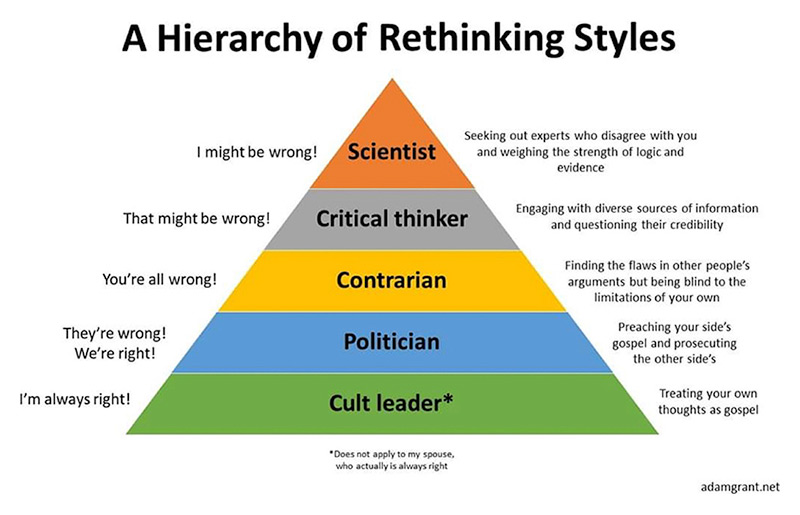
For instance, ask questions like an anthropologist—why people differ in their beliefs and behaviors. Understand the human brain like a neuroscientist—discover people’s ways of thinking, learning patterns, implicit biases; and spot behavior patterns like a social-psychologist—study how people feel, behave, and relate to each other.
We can adopt this scientific way of thinking to enhance equity in our business and talent strategy, and make it a vibrant part of our cultural DNA. With bold and audacious action, we can challenge outdated beliefs, change behaviors, and create a more equitable future.
Equity at Work: Donald Fan
This article is one of a three-part series on the topic of Equity at Work. With the heuristic study, the author aims to answer the fundamental question: Why and how does equity create value in corporate America. The first article, “Four Essential Levers CEOs Can Adopt to Achieve Racial & Gender Equality,” was published in the PDJ’s Fall 2020 issue, to discuss the leadership competencies needed to advance equity. The second piece, “Charting the Path to Equity in the Workplace,” in the PDJ’s 2021 Q1 issue, presents a case study demonstrating how business leaders elevate equity at work. In the third article, “How To Make Equity Center Stage All the Time,” the author further explores how to make systemic changes and integrate equity into business DNA.
Equity at Work

Donald Fan
Donald Fan serves as Senior Director in the Global Office of Culture, Diversity, Equity & Inclusion at Walmart Inc.
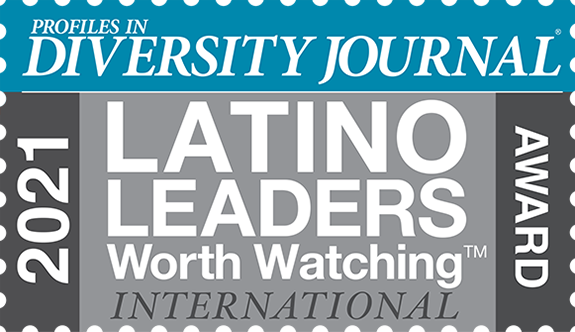
The 1st Annual Latino Leaders Worth Watching™ Awards
PDJ Salutes it Inaugural Class of Latino Leaders Worth Watching™ Award Winners
For more than two decades Profiles in Diversity Journal has honored outstanding individuals who have blazed new trails, welcomed challenges, mentored others, advanced diversity and inclusion in the workplace and the community, and excelled in their chosen fields. Now, PDJ is honoring Latino Leaders with our first-ever Latinos Leaders Worth Watching Awards.
The 38 profiles that appear in this issue recognize and celebrate the hard work and impressive achievements of these Latinos Leaders. Each award recipient has also provided us with the answers to some interesting questions and an essay that will give you, our readers, a chance to get to know these multitalented, multilingual, and trailblazing individuals a little better.
Welcome to PDJ’s first annual Latinos Leaders Worth Watching Awards.
2021 Latino Leaders Worth Watching™ Award Winners
- Akin Gump Strauss Hauer & Feld LLP – Estela Diaz – Partner
- Akin Gump Strauss Hauer & Feld LLP – Rubén H. Muñoz – Partner-in-Charge, Philadelphia Office
- Advanced Micro Devices – Christopher Aguilar – Corporate Vice President of Finance
- Advanced Micro Devices – Frank Azor – Chief Architect, Gaming Solutions and Marketing
- Advanced Micro Devices – Jay Carlos Nunez – Corporate Vice President, Strategic Accounts
- Advanced Micro Devices – Diane Ramos – Director HR Business Partner
- Best Best & Krieger LLP – Ruben Duran – Partner, Ontario Office Managing Partner
- Dechert LLP – Nazim (“Naz”) Zilkha – Corporate Partner
- Entergy Corp. – Eliecer Viamontes – Vice President, Utility Distribution Operations
- Fish & Richardson P.C. – Todd E. Garcia – Managing Principal–Boston, Corporate Secretary
- FordHarrison LLP – Allison Saunders – Managing Partner, Los Angeles Office
- Frantz Ward LLP – Marc A. Sanchez – Partner
- Freddie Mac – Christian Valencia – Vice President, Single-Family Credit Risk Transfer Capital Markets
- HP Inc. – Enrique Lores – President & Chief Executive Officer
- IMC Health – Carolina M. Veira – Director of Partnerships and Corporate Social Responsibility
- Jones Walker LLP – Luis Llamas – Partner
- Kelley Kronenberg – Michelle Martinez Reyes – Chief Relations Officer
- Keystone Alliance Mortgage – Andres J. Munar – Co-Founder/Owner
- Kindred Healthcare – America Jones – Chief Executive Officer, Kindred Hospital El Paso
- Latham & Watkins LLP – Antonio Del Pino – Partner & Global Chair, Latin America Practice
- Mayer Brown LLP – Matthew H. Marmolejo – Partner
- Moss Adams LLP – Yenifer Origel Hernandez – Risk Advisory & Compliance Manager
- The National Hispanic Corporate Council – Eduardo Arabu – Executive Director
- New American Funding – Patty Arvielo – Co-Founder and President
- New York Life Insurance – Jomil Guerrero – Managing Director, New York Life Investments; Head of Global Marketing Operations
- PNC Financial Services Group, Inc. – Pedro Viera, Jr. – Vice President, Business Banking
- S&P Global Inc. – Michael Bonilla – Senior Corporate Strategy Analyst
- S&P Global Inc. – Marcela Mikkola – Senior Research Associate
- S&P Global Inc. – Nicole Rodriguez – Senior Director, People Strategy Lead
- S&P Global Inc. – Paula Rojnica – Senior Director, Operations; Site Lead, Buenos Aires Office
- Therium Capital Management – A. Elizabeth Korchin – Senior Investment Officer
- UnitedHealthcare Global – Santiago Irurita – Vice President, Global Solutions Latin America
- UnitedHealthcare Global – Ximena Gloffka Wilmans – Vice President, Enterprise Business Intelligence
- Venable LLP – Nora E. Garrote – Partner; Co-Lead, Intellectual Property Transactions Practice Group; Partner in Charge, Diversity & Inclusion
- Walmart Inc. – Daniel Trujillo – Executive Vice President, Global Chief Ethics & Compliance Officer
- WilmerHale – Regina “Gina” Rodriguez – Partner
- Wilson Turner Kosmo – Carolina Bravo-Karimi – Partner
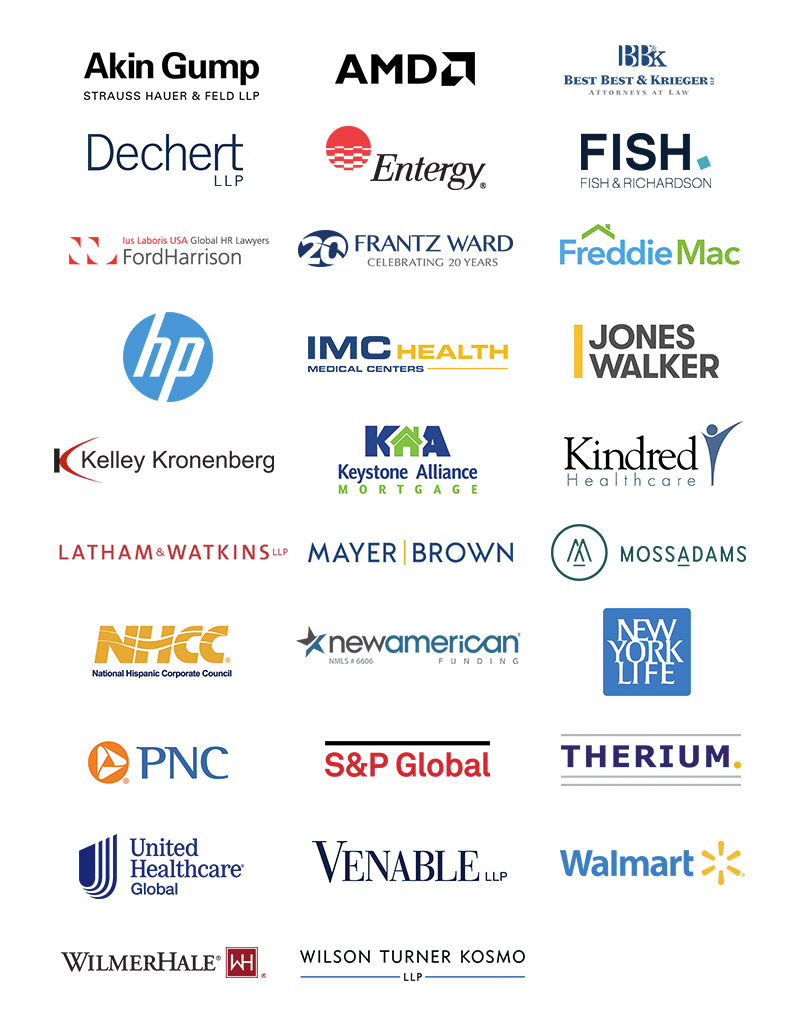
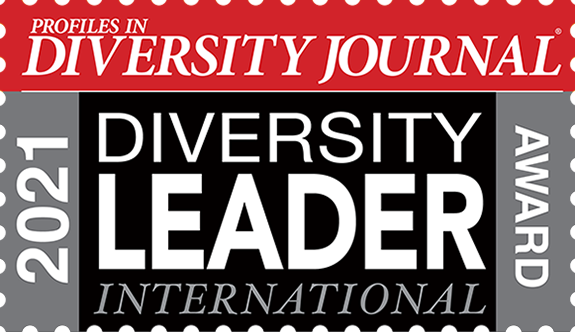
The 13th Annual Diversity Leader Awards
PDJ Celebrates the Creativity and Commitment of this Year’s Diversity Leader Award Recipients
Every year, since PDJ began celebrating organizations and individual Diversity Leaders who are committed to taking diversity to the next level, we have been impressed and encouraged by their commitment, their intelligence, and their creativity.
The Diversity Leaders we recognize in the following pages are reaching out, locally and globally, to embrace an ever-expanding variety of employees, vendors, clients, and communities. Diversity, inclusion, and equity are central to everything they do. For many, who at one time or another have felt excluded or ignored because they belonged to a particular gender, or ethnic or cultural group, making diversity a reality is a personal imperative.
This year’s Award recipients are working to connect with a more diverse group of potential hires, reaching out to women- and minority-owned vendors, supporting their communities, and teaching company leaders and hiring managers to recognize and confront their own unconscious biases. Most important, they are cultivating workplaces that invite all employees to bring their authentic selves to work every day.
We invite you to get to know these extraordinary Diversity Leaders. You may discover ideas and strategies that you can use to help drive your own organization along the diversity highway. And we know you’ll be inspired by their insights, their enthusiasm, and their inspiring personal stories.
2021 Diversity Leader Award Winners
- Council of Chief State School Officers (CCSSO) – Annie Holmes – Chief Equity Officer
- Dechert LLP – Satra Sampson-Arokium – Chief Diversity & Inclusion Officer
- Ernst & Young (EY) – Karyn Twaronite – Global, Americas & US Diversity & Inclusiveness Officer
- HP Inc. – Harvey Anderson – General Counsel
- LinkedIn – Rosanna Durruthy – Vice President, Global Head of Diversity, Inclusion & Belonging
- New American Funding – Patty Arvielo – Co-Founder and President
- New York Life – Keith McClain – Vice President and Global Head of Compensation
- RBC Capital Markets – Sandye Taylor – Global Head of Diversity & Inclusion
- Sephora – George-Axelle Broussillon Matschinga – Vice President of Diversity & Inclusion
- Walmart – Richard Mayfield – EVP, Global Sourcing & Regional CEO – Walmex & Canada
- Wayfair – KeyAnna Schmiedl – Global Head of Culture & Inclusion
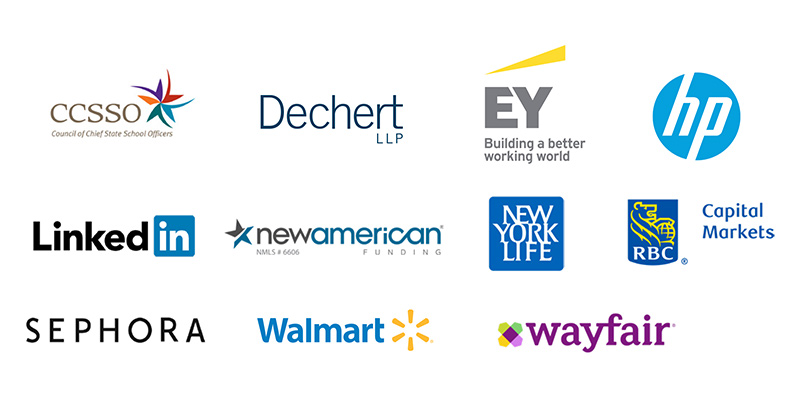
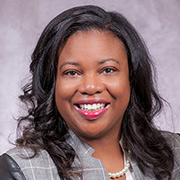
Annie Holmes
Chief Equity Officer
Council of Chief State School Officers (CCSSO)
Headquarters: Washington, DC
Industry: Education Policy Nonprofit
CEO: Carissa Moffat Miller, PhD
Website: www.ccsso.org
Her Credentials: BS, Temple University; M Ed (2) & PhD (ABD), Pennsylvania State University
Her Philosophy: Empowered Black Women Empower Black Women.
In 2020, Chief Equity Officer Annie Holmes and her team produced an internal Equity Summit to onboard all staff into the equity approaches that would be implemented going forward. They also were able to work with state education policy leaders to address systemic racism within the education system. And finally, they were able to convince 26 states to establish an equity leader position within the state education agency.
In 2021, Holmes plans to continue to build out additional strategies and policy shifts that will achieve even greater racial equity across the education system.

